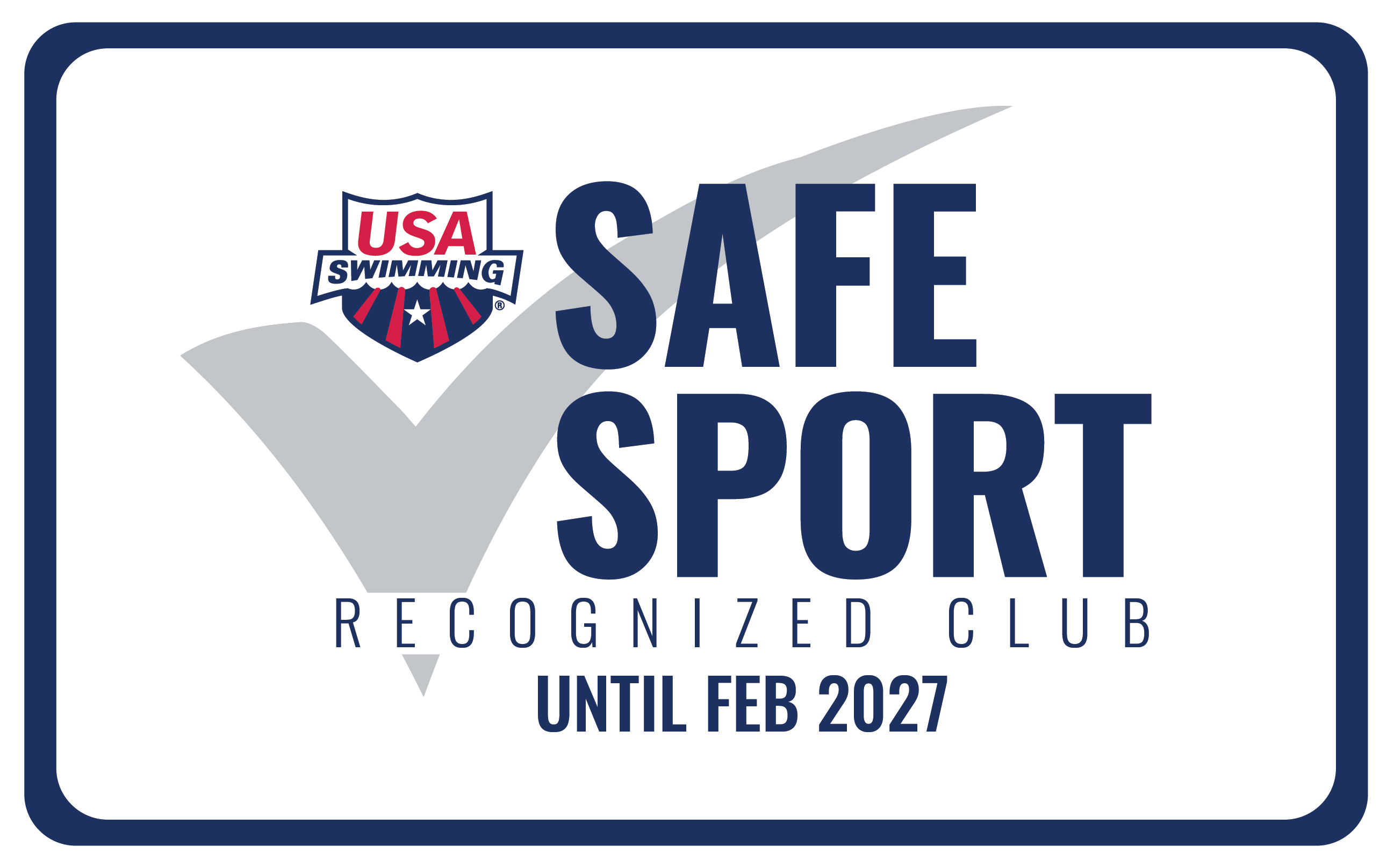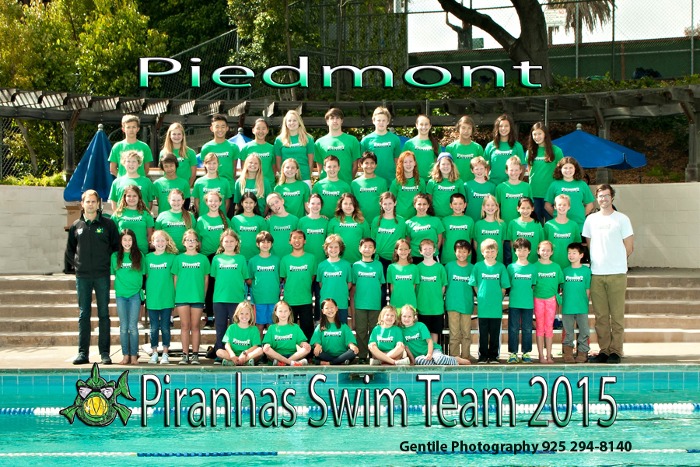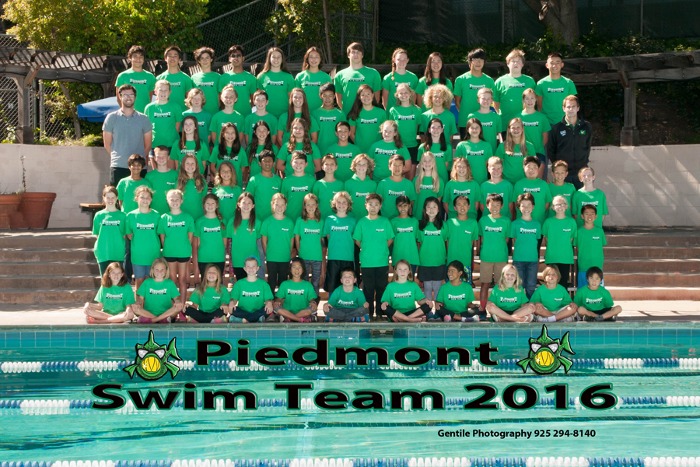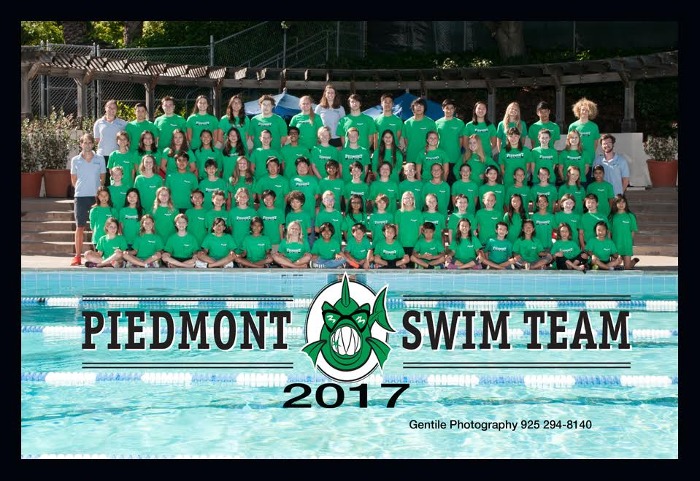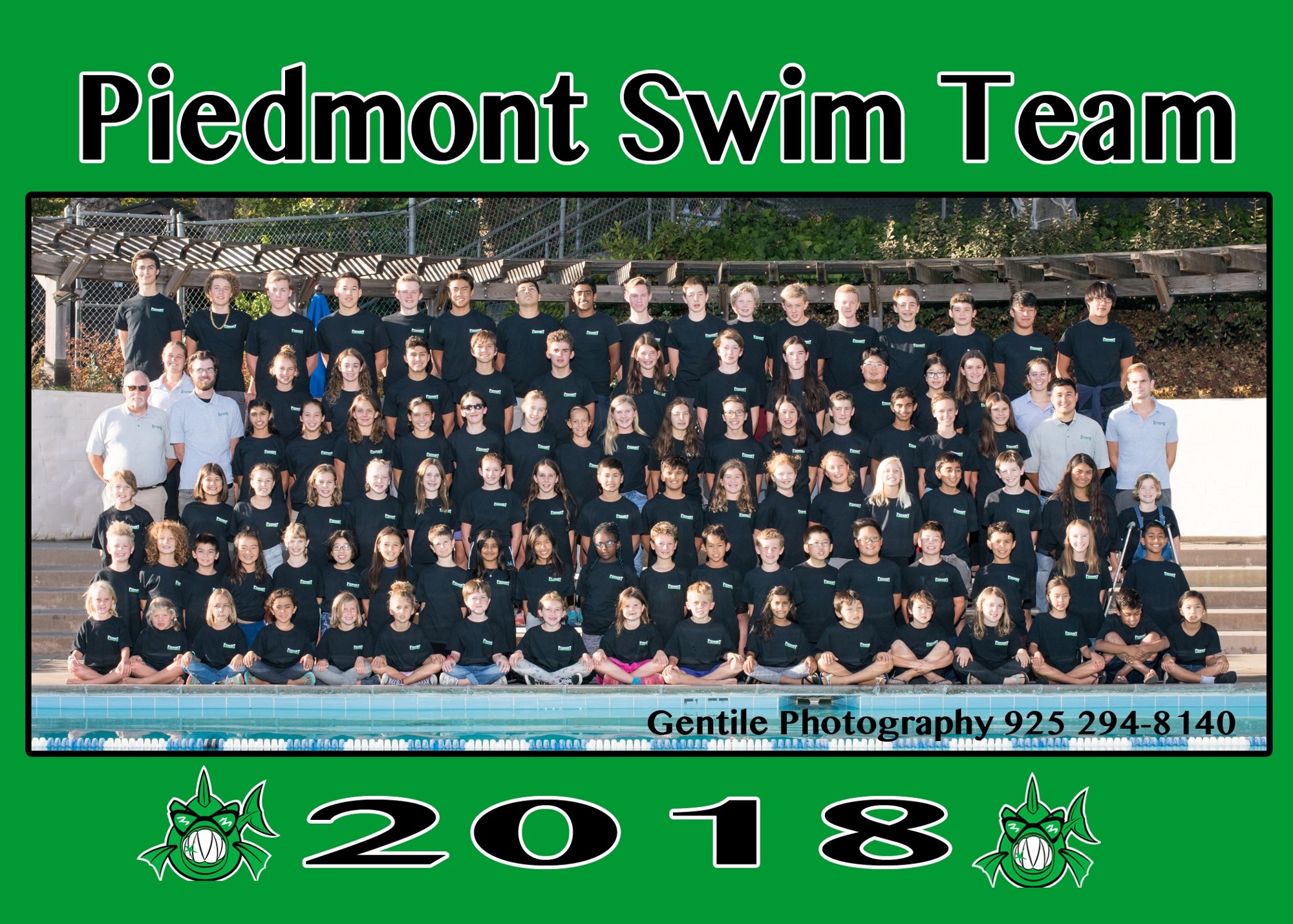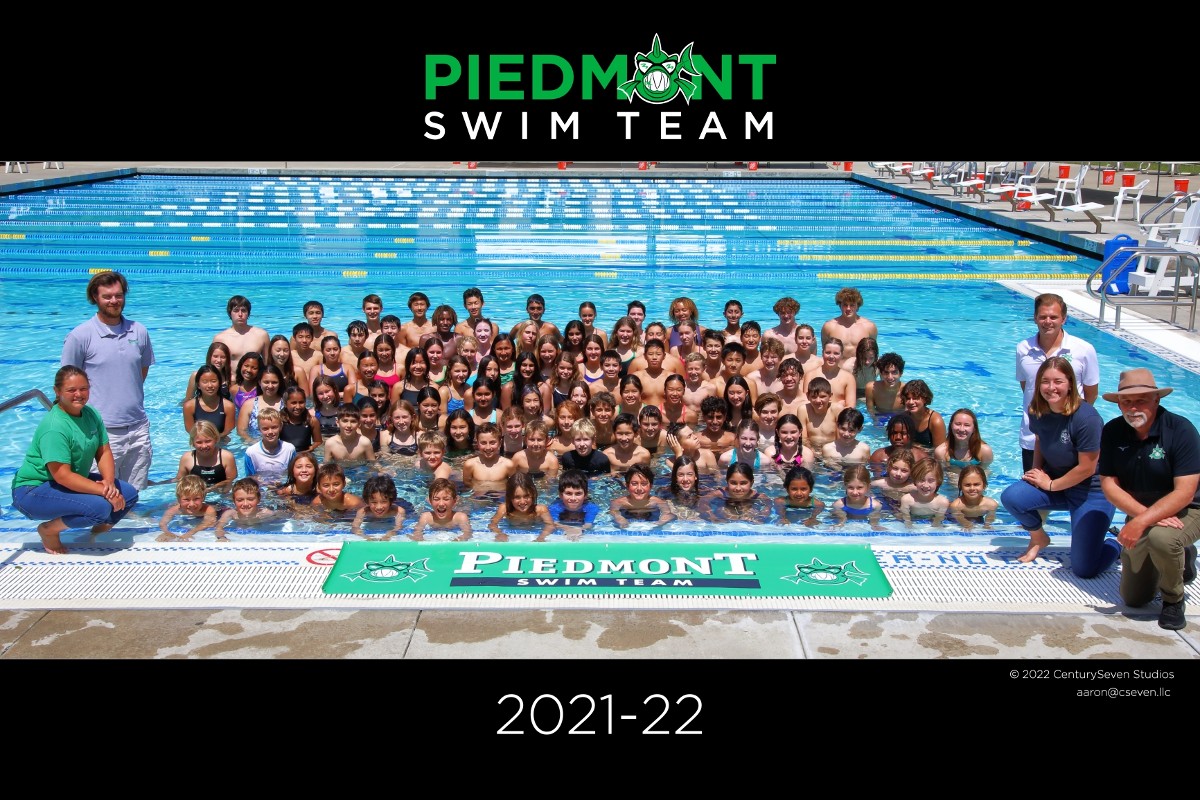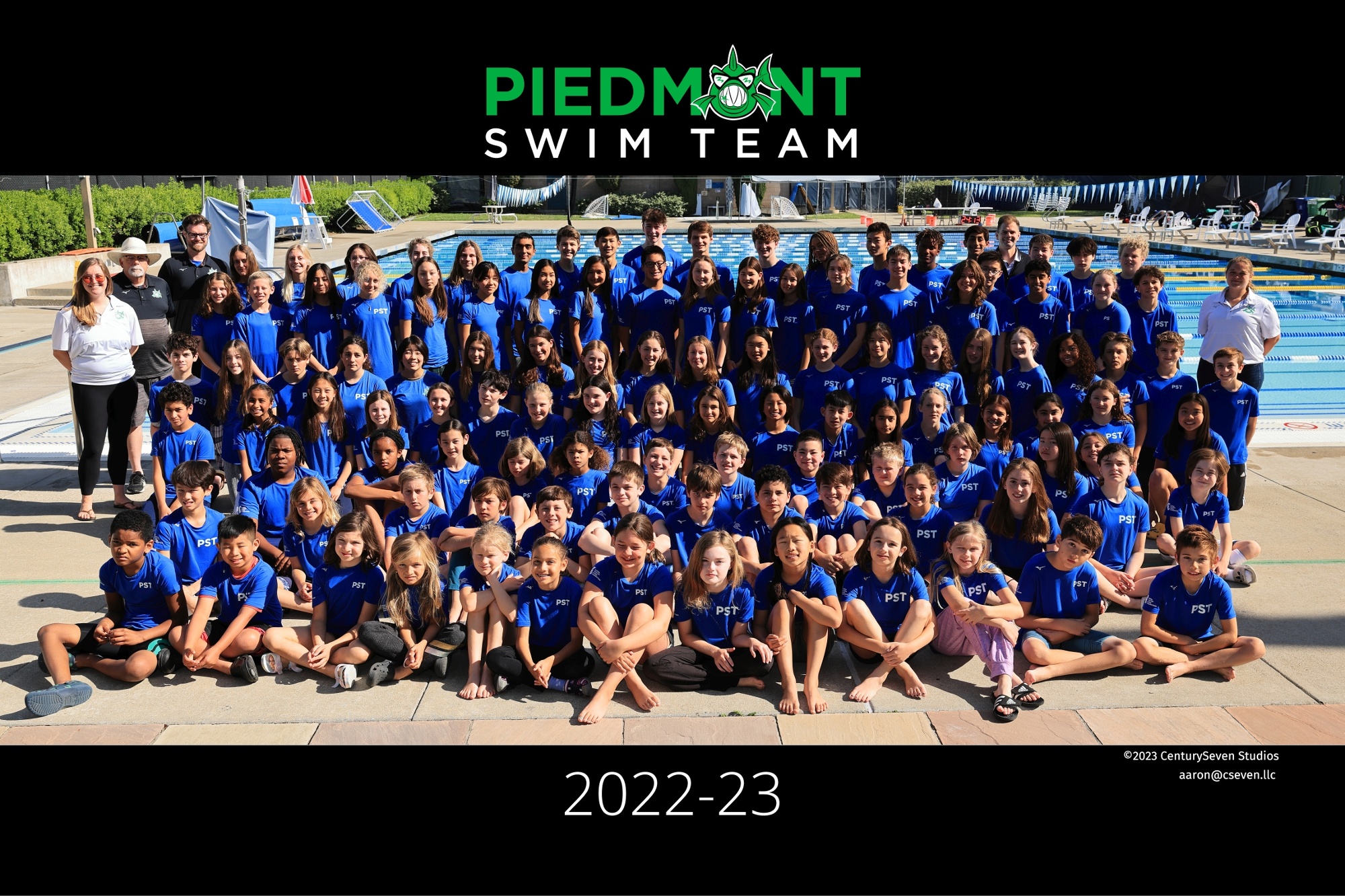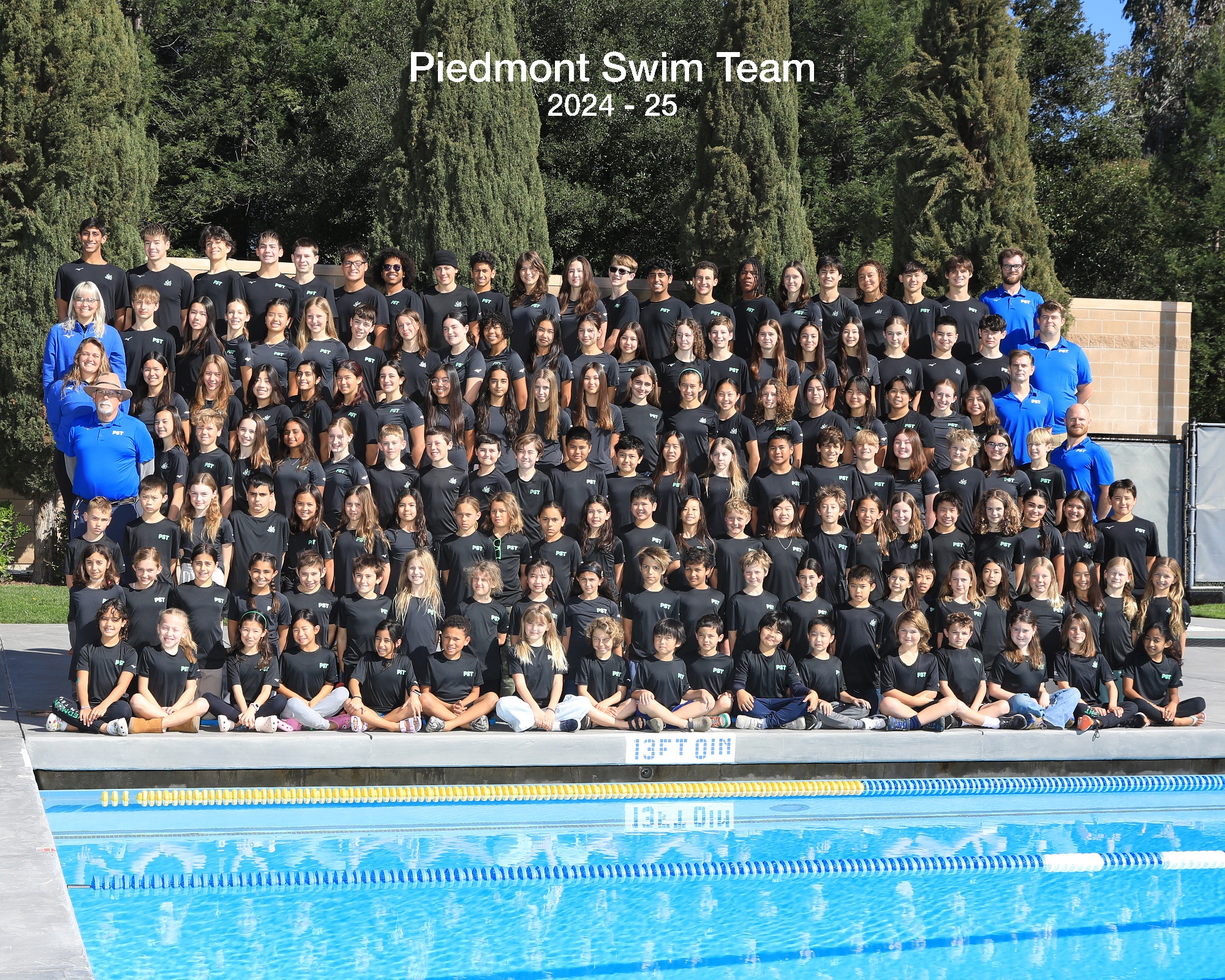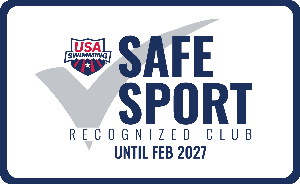MEETS! General Information, Time Standards, Helpful Tips and More…
We believe that every swimmer should have the opportunity to swim in a meet at least once per season. Meets are the cornerstone of a true “competitive” swimming program. Although meets can be somewhat intimidating for those new to the sport, they are also incredible opportunities to achieve, learn and – most importantly – have a blast while racing with friends and making new ones.
To that end, the Team has put together the following information designed to hopefully demystify some of the more challenging aspects of meets. We hope you find this information useful.
Registering your swimmer
There are currently two online platforms meet hosts can use for registrations: ome.swimconnection.com and FastSwims.com. While you can submit a paper registration (the entry form is at the end of every meet sheet), entering a meet via online registration is faster and will provide immediate confirmation of entry. Neither online meet registration service requires a membership, however both platforms do charge a small handling fee per transaction and require a credit card (the paper form does not charge a fee and you pay by check). You will need the following information the first time you register:
LSC organization: PC (Pacific Swimming)
Club Code: PST
Club Name: Piedmont Swim Team
Registration Number: Visit your USA-Swimming Account for registration number
Once you have registered on each platform, you will not need to enter this information again.
Which meets to sign up for
A calendar of meets PST intends to attend for the season can be found on the Events tab of our team website (piedmontswimteam.org). By clicking on the meet name, you can find a description of who should attend this meet. Some meets will require qualifying times or are intended for certain age groups. If you are unsure, please ask your coach! Note that meets generally do not open for registration until a few weeks prior to the meet. The Sunday newsletter will let you know when meets open for registration and provide a link to OME or FastSwims. We advise you to register ASAP after you receive this notification as many of the large age-group meets fill up very quickly.
IMPORTANT: If you are not available to work during the meet or can’t find someone to take your shift(s), PLEASE DO NOT SIGN YOUR SWIMMER(S) UP FOR THE MEET. The number of timing chairs and officials each participating team needs to provide are assigned by the host team based on the number of swimmers the team has entered. PST must provide the number allocated by the host team or pay a penalty.
As a result, even if you have fulfilled all of your general service hours, parents who sign their child(ren) up for a meet may be required to work at least once during the meet. Families with 2 or more swimmers attending a meet may be asked to cover two shifts per meet. If you know you will have limited availability, sign up for a shift early!
Picking events to swim
Once the meet is open and you have determined it’s appropriate for your swimmer, you will need to decide which events to enter your swimmer. All meets will have a meet sheet which, in addition to information on dates, venue, logistical details like parking and other restrictions, will list the events available to swim and the order of swim.
The coaches have put together the group-specific guidelines and suggestions below. These are only guidelines and are in no way absolute. While event selection is up to individual swimmers, we would be more than happy to provide guidance and suggestions. Keep in mind that meets may have a max number of events per day (noted in the meet sheet)
If this is your swimmer’s first meet, and they need a time in order to enter, please contact your coach and they can help estimate a good entry time for your swimmer. Once they have swum in an event, the time will automatically be in the USA swimming database and going forward, you can click on “best time” to auto-populate the fastest time as the entry time for that event.
If you are unable to contact a coach in time as meets close quickly and an entry time is required (the meet sheet will say “Entries with No Times or NT will not be accepted”), use this guideline to select an entry time:
| Event | SCY (Short Course Yards) | LCM (Long Course Meters) |
| 50 Free | 1:00.00 | 1:10.00 |
| 100 Free | 2:15.00 | 2:35.00 |
| 50 Back | 1:15.00 | 1:25.00 |
| 100 Back | 2:30.00 | 2:50.00 |
| 50 Breast | 1:25.00 | 1:35.00 |
| 100 Breast | 3:30.00 | 3:50.00 |
| 50 Fly | 1:25.00 | 1:35.00 |
| 100 Fly | 3:30.00 | 3:50.00 |
| 100 IM | 3:00.00 | 3:20.00 |
| 200 IM | 6:00.00 | 6:40.00 |
The purpose of entry times is to place your swimmer in a heat with similarly fast swimmers. If this is your swimmer's first meet, it is less stressful if they swim in the last heat with a slower entry time.
Blue and Bronze:
- Talk to your swimmer and find out what strokes they like to do…we want our younger swimmers to have a positive experience with their first meets!
- If it’s your swimmer’s first meet, Freestyle and Backstroke events tend to be safe to start with.
- We encourage swimmers to try out a few different events as well, including butterfly and breaststroke. While disqualifications are common in these events in younger age groups, it’s good to encourage your swimmer to branch out once they feel comfortable
Silver:
- Generally by this group, a swimmer will have a pretty good idea of their favorite strokes and events and we encourage them to continue to compete in these.
- Advancement to these groups is often accompanied by an age-up that includes events of longer distances. Don’t be afraid! The training is designed to support these events. We encourage these swimmers to enter the longer distance events, including 200’s and the 500 free where applicable. Many strong distance swimmers are never discovered until this age group…it’s a great opportunity to shine! If it turns out it’s not your swimmer’s thing, we will not insist on repeat performances, but it’s great to try everything once.
- Swimmers in this group should also start to have an awareness of championship meet cuts and time standards; swimmers close to achieving a championship cut or time standard should swim these events at EVERY meet entered in order to gain experience and practice race strategy.
- In preparation for advancement to the Senior levels, we will expect swimmers to have at least attempted every stroke/distance event combination available in their age group.
Gold and Platinum:
- By this time, these swimmers should have a well-defined set of best events that should be entered with regularity in the main season.
- As racing and race strategy are paramount for this group, we encourage regular racing, even in non-specialty events; the more you race the more you learn.
- Swimmers should be well aware of championship cuts and time standards in their key races. Strategy will be built around achieving these goals.
IMPORTANT: once you have successfully registered, you will receive an email confirmation. If you need to make any changes to the events or entry times, you are usually able to go back in to the site and make changes before the meet closes (e.g update entry times, switch events if an event hasn’t reached a cap). Meet hosts will not refund you for any reason (except if meet is canceled) once you have paid.
Service requirement at the meet
As detailed in our service hour policy, you are required to sign up for a job during the meet if your swimmer is entered in a meet. Job sign-ups will be open on the team website on the Monday morning before the meet. Find open jobs that suit you and your schedule, and please include the person who will actually be working AND a contact number in the comments.
Jobs include bringing or returning team canopies and buckets/bungees, timing, officiating (you must be trained), or being the day of volunteer coordinator.
Sign-ups close Wednesday evening and unfilled job slots will be assigned the Thursday morning before the meet and it is expected parents will read their reminder emails AND check the PST website to understand the assignment(s). Once assigned, if you cannot fulfill the shift, it is your responsibility to find a replacement or switch. There is a $100 No Show penalty per assignment.
NOTE: If your swimmer is entered but doesn’t attend the meet, regardless of circumstance, you are still responsible to fulfill job assignments or will be charged a $100 No Show penalty for each missed assignment.
The Anatomy of a Swim Meet
Although details may vary, swim meets generally follow the same flow. In this section, we will give you the start to finish rundown of a day at a typical age group meet.
Arrival at the Pool
Generally sometime between 7-7:30 am. It is advised that you arrive at the pool with your swimmer a minimum of 15 minutes prior to the announced start of warm-ups (Warm-Up times are announced in Sunday’s newsletter). This will give you and your swimmer a chance to:
- Check in for events
- Find the team area and get chairs, bags, etc, set up
- Change into your swimsuit
- Generally orient yourself with the layout of the pool area
Event Check-In
FIRST AND FOREMOST, a swimmer will need to check-in for the events they have entered that day. This is to ensure that events are seeded only with swimmers actually present at the meet. There is a desk set up with check in sheets usually organized by boys/girls, then by age group. Your swimmer should be able to check in for all of their events on a given day before or during warm-ups, with the close of each event most of the times no more than 30 minutes before the estimated time of the start of the first heat of the event. Some meets specify that check-in will close at 10:30am. If you are registered to swim Saturday and Sunday, you will need to check in again on Sunday.
Neglecting to check-in for an event before it closes means your swimmer will NOT be allowed in an event, even if you have registered and paid for the entry. Please make sure your swimmer is checked in – and it must be by the swimmer (or coach if there is an extenuating circumstance) not the parent! Once the event is closed, they will not seed you unless the mistake is theirs. It is advised that you bring a hard copy of the OME registration confirmation email (or have it on your phone) just in case there is any confusion.
Warm-ups
Warm-ups are generally sometime between 7:30 and 8:45. Team warm-ups are MANDATORY. Warm-ups are extremely important to your swimmer’s success at a meet. They give your swimmer a chance to:
- Get warmed up and ready to race!
- Familiarize themselves with the competition pool. All pools have their minor differences and it’s good to know these things before going into a race. A swimmer will get comfortable with the water temperature, wall targets, any touchpads or bulkheads in place, and get a general feel for the course.
- Familiarize themselves with the starting blocks, which can vary widely from pool to pool.
Warm-ups are done at one time as an entire team. At certain meets the coaches may choose to split-up the warm-up session into groups, . If so, this will be communicated beforehand. 8 and under swimmers generally have separate warm up sessions at 8:45-8:55am, though not always. Please check the newsletter or coaches email prior to the meet.
The warm-up session is open to ALL participants from ALL teams of a meet. The pool is generally sectioned off into “General Warm-Up” for basic swimming, kicking, drills, etc; “Push-Pace”, one or two lanes generally reserved for faster sprints, and “Starts”, where swimmers can dive off of the block ONLY under coaches’ supervision.
**Helpful information regarding Warm-Ups: As stated above, warm-ups are open for all swimmers in a meet. As you might imagine, it’s CROWDED. This can be very hectic, and often intense for newer swimmers. IT IS IMPERATIVE THAT ALL SWIMMERS BE ON TIME FOR WARM-UPS. The larger our group is at that time, the better lane position we can get for warm ups. In spite of this, it is still to be expected that lanes will be crowded, and there will be swimmers from other teams in our warm up lane(s). This is all just part of the experience!
We advise parents of newer/younger swimmers to be ready somewhere near the exit of the pool with towels, etc. at the end of warm-ups. This area will be crowded, chaotic and possibly overwhelming for new swimmers. Being ready to find your swimmer and lead them back to the team area will help make this a positive experience for everyone.
Start of the Session
Generally at 9am. At a general age-group meet, this will mark the start of the meet. At a meet with prelims and finals, this will mark the start of the prelims session. The meet will start with Event 1, Heat 1, whatever that may be.
Your Swimmer’s Events
As each event is closed, your swimmer’s heat and lane assignments will be posted on heat sheets posted around the pool deck. It is your swimmer’s responsibility (with your help) to know their heat and lane assignments, and to show up where they need to be at the right time. The coaches are not available to bring swimmers to the blocks as they are watching other swimmers. We encourage swimmers to check heat and lane assignments together.
Many parents and swimmers choose to write their event number, heat and lane on the back of their hand with a Sharpie for easy reference (and it looks legit at school the next day). It can be helpful for newer swimmers in the same age group with the same events to travel together to the blocks.
Swimmers: The race
- Before your race– let the coaches know your heat and lane as soon as it’s posted and time permitting. This is a great time to get focused on one or two important things to think about during the swim, and to touch base on race strategy. Swimmers may be advised to get in a short warm-up prior to the start of their race. This is especially important on long meet days when there are long periods of sitting in between events.
- Going behind the blocks before your heat– it’s usually best to be behind the blocks 2-3 heats before your race. Make sure you have your cap/goggles on, as well as a parka and shoes if it’s cold. You can toss off your parkas and shoes and collect them after you swim. We want to make sure you don’t ruin a perfectly awesome event by freezing for 10 minutes before your race starts!
- During your race – HAVE FUN! THIS IS WHY WE’RE HERE! GO PST!!
- If you miss your race – (miss the race/do not show up to the blocks) you will not be penalized unless the meet is a trial and finals or high ranking meet. If there are any remaining heats left in the event you may be able to swim if there is a spot open and after you see the starter (official at the starting blocks area). If there are any penalties, it will generally say in the meet sheet what the penalties are if any.
- After your race – it’s VERY important that your swimmer come and talk to the coaches AFTER each race. During this time, we’ll go over things you did well and things we’re going to continue to work on. This is our opportunity to celebrate your successes with you and plan our next moves to make sure they continue! When appropriate, the coaches may advise you to warm down first, prior to coming to talk with us.
- Warm down– warm down is as important as warming up. Doing a thorough warm down ensures you will eliminate much of the lactic acid that has built up in your muscles during your race, and will prevent you from feeling sore and tired later in the meet. For the maximum benefit, you should start your warm down ASAP after your race. The coaches will give you suggestions and guidelines for your warm-down when you talk with them. If the meet has no warm down pool, make sure you do plenty of stretching after your swims!
In-Between Your Events
This will take up the majority of your day! At age-group meets, there will often be long waits between your swimmer’s events; if they have only entered one or two events on a given day, there could be upwards of 2-3 hours between their events. It’s best to be prepared for these long intervals. It’s important that your swimmer stay warm (or cool if it’s hot out!) and relaxed during this time. Drinking water and having a few small, nutritious snacks is a great way to make sure their energy level stays high throughout the day.
This is also a great time to hang out with your teammates! Take the opportunity to watch other races, and cheer for your PST teammates as they swim their events. Just make sure you are paying attention to the meet so you don’t miss your events.
It may also be good to bring a book, homework, etc. to make efficient use of your swimmer’s down-time.
Relays
Relays are generally conducted at the end of the meet. Coaches will inform swimmers if they are entered into relays. Some swimmers may be invited to be a relay-only swimmer at a championship meet. In this case, you do not sign up for any events, just make sure to coordinate with your coach.
Relays can also be one of the more chaotic moments of a meet; for new/younger swimmers, it’s great to have parents close by to help your swimmer and their relay teammates navigate to and from the blocks during this time.
The coaches will do the best we can to help, but we may be unavailable if we’re busy watching other swimmers.
End of the Session
If the meet does not have a separate finals session, you and your swimmer are free to leave after the completion of their final event and the completion of your volunteer job, although we encourage everyone to stay and cheer on their teammates.
If the meet DOES have a finals session, the pool will close after prelims and there will be a break before the finals session begins. The start time for finals will either be announced or previously published.
Meet Results and Awards
All results are posted at the pool area shortly after the event has been swum. Usually the events are split between boys and girls. Remember, all girls' events are ODD and boys' events are EVEN. The results will be categorized in each division C, B, BB+. Each swimmer is responsible for picking up their own awards or asking a friend to do it for them. To pick up your awards you need to know the event number you placed in and check to see if you are eligible for an award before going to collect them. Awards are NOT sent to swimmers after the meet or provided to a coach. Typically, there is an “awards table” set up some place at the meet. Ribbons are typically won for 1 – 8 places for each event. An “A” medal is given when a new “A” time for an age group is achieved, regardless of the place of finish.
Finals
If a meet has a finals session, the top 8 or 16 swimmers that will be swimming in the finals session will generally be posted soon after their event in prelims finishes.
Swimmers competing in finals will have a short team warm-up session prior to the start of the finals session. The coaches will let them know what time they need to be there for warm-ups.
Since there are usually only one or two heats per event in finals, this session tends to be MUCH faster and shorter than the morning session.
Coaches – talk to us!
We love meets and they’re the reason that we do everything we do in practice. Meets are supposed to be fun and exciting and we want to share this with your swimmers! Please don’t hesitate to send them over to talk to us about their swimming.
Most of the time one or all of the coaches will try to post up at a single location near the edge of the pool deck, but we may move around in order to watch PST swimmers or to take care of other coaching business. We may even sneak in a cup of coffee :) We want to make sure every swimmer feels like they can approach us during meets with any questions or concerns they might have, so locate your coaches seating area at the start of the meet!
What to do if your swimmer needs to leave the meet midway
Sometimes there are circumstances that may require you to leave a meet before swimming all your events. We recommend that you let the coaches and officials know that you will be mising events. If Heat and Lane assignments are already out, please let the Starter know which events you will be missing and what heat and lane you were assigned. This way the meet does not get delayed while waiting for you to show up at the blocks. If the Heat and Lane assignments are not out yet, please go to the check in desk and scratch your event, or talk to the admin official in the office if check in has already closed. If you are missing the entire day, please email your coaches and let them know, but no need to worry about events as you will be automatically scratched if you don't check in. If the events are preseeded, please follow instructions on the meet sheet to scratch your events.
Helpful Tips
- Meets can be long. There is nothing we can do about this, and it’s best to bring plenty of entertainment for both yourself and your swimmer. We will try and let you know in advance if we anticipate an exceptionally long day.
- The coaches try to pick a variety of meets every season; some we have been to and some new ones. Not all meets are the same, although once we find a GREAT meet, we will always try to return. If you really like, or really don’t like, a particular meet, let us know!
- Parking can fill up very early at many pools, and you may have to walk a number of blocks from where you park to get to the pool. Take this into consideration when planning what time to leave your house in the morning.
- Junk food is plentiful and cheap at swim meets! While the coaches agree that nachos, donuts and hot dogs can be delicious, it’s best to save these treats for AFTER the meet. Sitting and playing Angry Birds for 2 hours while eating nachos and drinking diet coke is not the best way to swim your best, we promise. We recommend bringing along granola/protein bars, fruit/veggies, sandwiches, etc, as healthy snacks can be few and far between at age group meets.
- Meets in the winter can be COLD, and possibly rainy. Meets are rarely canceled for inclement weather. If you know it is going to be a long, cold, day, be sure to bring plenty of warm pants, socks, sweaters, shoes (not flip flops), TEAM PARKA, hats and gloves, and be sure to wear them!
What to Pack
- Your white Mizuno PST Team Cap (mandatory), plus an extra in case yours rips. This does happen.
- Goggles, and it’s good to have an extra pair of these as well.
- PST attire – parkas, warm-ups, t-shirts, sweatshirts
- Socks and shoes, and wear them. These can be Uggs, running shoes, etc. when cold outside, and flip flops during warm weather
- Towels, and it’s good to have more than one. (Suggestion: one towel for every event)
- Extra clothing – keep in mind things will get wet. Good to have an extra set of dry clothes.
- Sunscreen, you will be outside all day.
- Games, books, etc.
- Sleeping bag and/or blankets, and folding chairs. These will be set up in the team area to ensure that everyone has a spot to sit. NOTE to parents: as our team has grown, we are finding space in the team canopies to be limited and have asked them to be for swimmers ONLY. Parents are always welcome to bring their own canopies - you will make many friends this way!
- WATER, Vitamin Water, Gatorade, etc., and healthy snacks like fruit, granola bars, PBJ, veggies, etc. Most often concession stands are stocked with nachos, candy and Costco pastries. Tasty, but not great for an athletic event. Save these for little rewards once you finish your racing for the day.
In the winter, meets can be very cold and very wet. Besides the team canopy, there may be little to no dry/indoor space for swimmers and parents.
For parents who are working/timing, you probably want to bring warm/waterproof clothing as it could be damp. Timing areas are generally somewhat tented, but not waterproof. Summer meets can be long, hot and offer very little shade. Make sure you bring plenty of fluids and stay hydrated. Sun hats, baseball caps and sunglasses will all help keep you comfortable.
Jargon and Vocabulary
blocks: also called the “starting blocks”, these are found at one (or both) ends of the pool and are the platforms off of which swimmers start their races. Blocks can vary drastically from pool to pool. Not all blocks are made equal. It’s important that swimmers familiarize themselves with the blocks at a pool during warm ups.
canopy: these are the portable “pop-up” tents that mark the team’s sitting area. These are great for staying cool in the sun and staying dry in the rain. The team owns canopies that are the responsibility of parent volunteers to take to and from meets.
cuts: sometimes also called “time standards”, though they can mean different things. Cuts are the time a swimmer has to have swum to attend a certain meet. All championship meets have cuts in order to enter. “Making cuts”, or swimming a certain time to make it to a certain meet, is a big focus of competitive swimming. You will often hear talk of “JO Cuts” and “Far Western cuts” in conversation. These basically mean the times needed to swim at these meets. Each event has its own cut. JO’s and Far Westerns have cuts by age group; higher level meets, such as US Nationals, only have one time standard per event.
“DQ’d”: or disqualified. Swimmers will be notified either by a meet official or by the coaches when they are disqualified in a race. The time does not count and no points are scored.
events: meets are made up of events, or combinations of distances and strokes. For example, 100 free is an “event”. Events, and the order in which they are swum, can change from meet to meet and are detailed in the meet sheet. Girls events are almost always odd-numbered, and boys events are almost always even-numbered.
An example of a hypothetical event block:
Event 1: 8&u Girls 25 back
Event 2: 8&u Boys 25 back
Event 3: 9-10 Girls 50 back
Event 4: 9-10 Boys 50 back
Event 5: 11-12 Girls 50 back
Event 6: 11-12 Boys 50 back
Event 7: 13-14 Girls 100 back
Event 8: 13-14 Boys 100 back
Event 9: 15+ Girls 100 back
Event 10: 15+ Boys 100 back.
Note that at some meets (senior, championships, etc.) there may be no age-groups attached to events. All ages swim together. This is generally seen at higher levels of competition.
false start: much like in other sports, this happens when a swimmer dives in, falls in, or flinches after “taking their mark”, and prior to the start button going off. . Swimmers are disqualified if they false start . You will also often hear people say the phrase, “He jumped”; this basically means he false started. False starts can also happen on relay exchanges, when the feet of the swimmer on the block leave before the swimmer in the water has touched the wall.
finals: also used synonymously with the “night” session. Finals are run after a given prelims session. At championship meets, generally but not always, finals are often started in the evening, around 5 or 6pm (as these things tend to vary meet-to-meet, the coaches will communicate meet timelines when applicable). Swimmers that place finish top 8 in an event during prelims swim in finals at night. The event is not scored until finals are complete. A swimmer that is first after prelims but 8th in finals officially finishes…8th. Often a second heat of semi-finals will swim, with those placing 9-16 in prelims competing in this heat. It is generally quite a prestigious accomplishment for a swimmer to make either finals or semi-finals (also called “making it back”).
heats: events are usually comprised of multiple heats. Heats are generally swum with the fastest heats starting first, and the slowest heats swimming last. At meets, your swimmer will have a combination of a heat number and lane number for each event (i.e., for the 50 back, I am in heat 4 lane 6). Note that while lanes are pretty easy to determine (look at the number on the orange cones, which might not correspond to the sticker on the block), there can sometimes be 10+ heats per event, and it is not always obvious which heat is in the water. If you know you have a swim coming up, it’s best to pay close attention to the heats by listening to the announcer and looking at the scoreboard.
heat winners: this is the swimmer that places first in a given heat. This is NOT the same swimmer that wins the event overall (although it can be). Some, but not all, meets recognize heat winners with special ribbons or awards.
meets: the word used to describe any formal meeting of two or more teams. Meets can be of many different varieties, which will be described in a later section.
meet sheet: the meet sheet is usually a 1-3 page hand out provided by the meet’s host team that provides general information about the order of events, meet timeline, location, parking, rules for entry, etc. While we will do our best to send a link to the meet sheet, the meet sheet can always be found on Pacific Swimming’s website (PacSwim.org). It’s a great resource for basic information about the specifics of that meet.
prelims: or trials, also referred to as the “morning” session of any dual session meet (championship or otherwise) Prelims are swum in heats, fastest to slowest, with the fastest swimmers moving on to the later finals session. See “finals” for more information. Meets that do not have separate finals are referred to as “timed finals”, meaning that the final results from the morning session are the true final results.
psych sheet: a psych sheet lists the seed times of all the swimmers registered in each event. It allows you to see how you are seeded compared to other swimmers in a particular event. It does not have heat or lane assignments.
relays: relays are made up of 4 swimmers, and are generally swum at either the beginning or end of the meet. Medley relay is raced in the following order: backstroke, breaststroke, butterfly, freestyle. Freestyle relays are all freestyle. Relays and the order of swimmers is always the coach’s decision.
scoring: in most meets, points are general scored for 1st-16th place. This can vary widely however, with some meets only scoring 1st-8th, some 1st-6th, and other scoring out to 24thplace. Additionally, awarding ribbons, trophies and awards vary widely from meet to meet as well. In cases where a swimmer or relay is disqualified, no points are officially scored.
splits: splits are times taken a points during a race. The coaches get these times with a stopwatch (occasionally off the scoreboard) and record them for later discussion. For example, in a 200 free, a coach may take splits after each 50. This means the coach is recording the time it takes the swimmer to complete each 50. Splits, and effective “splitting” are vital to race strategy and execution.
starter: the starter is the meet official responsible for sending off each heat. This is the person responsible for saying “swimmers take your mark”, and pushing the start button. The starter is also responsible for judging whether or not there is a false start.
time-standard: this is the time used to measure a swimmers level according to Pacific Swimming or United States Swimming (the local and national governing bodies of the sport, respectively). Often used synonymously with “cuts”, but these are not the same. Time-standards are not a function of PST’s grouping system, nor are they related. Time-standards indicate that a swimmer is at a particular level (B/A/AA/AAA/AAA). Standards for higher level meets such as JOs, Far Westerns, etc can change from year to year (and sometimes between summer and winter) and are posted on the PacSwim.org website under the Times/Time Standards tab.
warm-up: as in the warm-up session, not the clothing. Warm-ups are an exceedingly important aspect of the meet and are integral to a swimmer’s meet performance for many reasons.
warm-down: Warming down is recommended for everyone after every race. During a race, a huge amount of lactic acid builds up in our muscles. This is what’s responsible for making us feel “sore” after a hard race or practice. Warming down allows your body to flush out that built up lactic acid and keep you feeling fresh and energized for your next race.
warm-down pool: Most, but not all, of the pools we will compete in will have a separate warm up/warm down pool on site. These are usually smaller pools or diving wells reserved exclusively for this purpose. It’s important that these pools are used for just that purpose and are NOT used for playtime. Other pools might only have one lane in the main competition pool reserved for warm down.
Helpful Apps
Two apps that are handy to have on your mobile device are OnDeck and Meet Mobile:
- OnDeck - OnDeck is the mobile app for the TeamUnify platform which powers our team website. Through this app, you can find your swimmer’s attendance, best times by event, meet results, billing info and more. It is free to install and uses the same username and password as you use to log in to our team website.
- Meet Mobile - For meets that use Hy-Tek software, this app gives you access to psych sheets and heat and lane assignments. For a small subscription fee, you can also get real-time results. Just launch the app and search by a keyword such as location of meet to find the correct meet. No more running to the boards to find your heat/lane or results!
